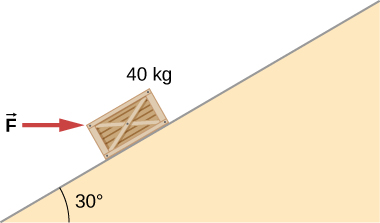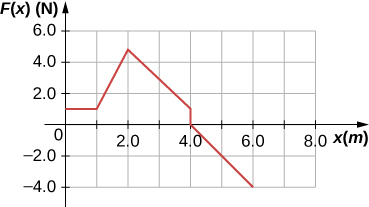| << Chapter < Page | Chapter >> Page > |
A crate is being pushed across a rough floor surface. If no force is applied on the crate, the crate will slow down and come to a stop. If the crate of mass 50 kg moving at speed 8 m/s comes to rest in 10 seconds, what is the rate at which the frictional force on the crate takes energy away from the crate?
160 J/s
Suppose a horizontal force of 20 N is required to maintain a speed of 8 m/s of a 50 kg crate. (a) What is the power of this force? (b) Note that the acceleration of the crate is zero despite the fact that 20 N force acts on the crate horizontally. What happens to the energy given to the crate as a result of the work done by this 20 N force?
Grains from a hopper falls at a rate of 10 kg/s vertically onto a conveyor belt that is moving horizontally at a constant speed of 2 m/s. (a) What force is needed to keep the conveyor belt moving at the constant velocity? (b) What is the minimum power of the motor driving the conveyor belt?
a. 10 N; b. 20 W
A cyclist in a race must climb a hill at a speed of 8 m/s. If the mass of the bike and the biker together is 80 kg, what must be the power output of the biker to achieve the goal?
Shown below is a 40-kg crate that is pushed at constant velocity a distance 8.0 m along a incline by the horizontal force The coefficient of kinetic friction between the crate and the incline is Calculate the work done by (a) the applied force, (b) the frictional force, (c) the gravitational force, and (d) the net force.

If crate goes up: a. 3.46 kJ; b. −1.89 kJ; c. −1.57 kJ; d. 0; If crate goes down: a. −0.39 kJ; b. −1.18 kJ; c. 1.57 kJ; d. 0
The surface of the preceding problem is modified so that the coefficient of kinetic friction is decreased. The same horizontal force is applied to the crate, and after being pushed 8.0 m, its speed is 5.0 m/s. How much work is now done by the force of friction? Assume that the crate starts at rest.
The force F ( x ) varies with position, as shown below. Find the work done by this force on a particle as it moves from to

8.0 J
Find the work done by the same force in [link] , between the same points, , over a circular arc of radius 2 m, centered at (0, 2 m). Evaluate the path integral using Cartesian coordinates. ( Hint: You will probably need to consult a table of integrals.)
Answer the preceding problem using polar coordinates.
35.7 J
Find the work done by the same force in [link] , between the same points, , over a circular arc of radius 2 m, centered at (2 m, 0). Evaluate the path integral using Cartesian coordinates. ( Hint: You will probably need to consult a table of integrals.)
Answer the preceding problem using polar coordinates.
24.3 J
Constant power P is delivered to a car of mass m by its engine. Show that if air resistance can be ignored, the distance covered in a time t by the car, starting from rest, is given by
Suppose that the air resistance a car encounters is independent of its speed. When the car travels at 15 m/s, its engine delivers 20 hp to its wheels. (a) What is the power delivered to the wheels when the car travels at 30 m/s? (b) How much energy does the car use in covering 10 km at 15 m/s? At 30 m/s? Assume that the engine is 25% efficient. (c) Answer the same questions if the force of air resistance is proportional to the speed of the automobile. (d) What do these results, plus your experience with gasoline consumption, tell you about air resistance?
a. 40 hp; b. 39.8 MJ, independent of speed; c. 80 hp, 79.6 MJ at 30 m/s; d. If air resistance is proportional to speed, the car gets about 22 mpg at 34 mph and half that at twice the speed, closer to actual driving experience.
Consider a linear spring, as in [link] (a), with mass M uniformly distributed along its length. The left end of the spring is fixed, but the right end, at the equilibrium position is moving with speed v in the x -direction. What is the total kinetic energy of the spring? ( Hint: First express the kinetic energy of an infinitesimal element of the spring dm in terms of the total mass, equilibrium length, speed of the right-hand end, and position along the spring; then integrate.)

Notification Switch
Would you like to follow the 'University physics volume 1' conversation and receive update notifications?